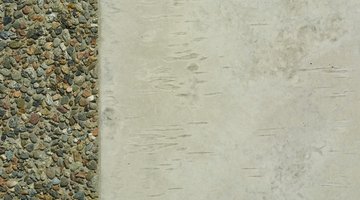How to Raise the Level of a Concrete Slab Without Slabjacking or Lifting
There are several reasons why you might want to raise the level of a concrete slab. Sometimes, slabs settle over time, allowing annoying puddles to form whenever it rains. Slabs also can crack, flake or deteriorate, making them more of a liability than an asset.

Slabjacking is a major undertaking that shouldn't be done by an amateur. A much easier solution is to pour a new slab on top of the old one, raising it to the level you want and making it look like new.
Things You Will Need
- Stiff-bristled broom
- Phosphoric acid, muriatic acid, concrete roughener or and sandblaster
- Vacuum
- Concrete forms
- Heavy rocks or concrete blocks
- 4-foot level
- Line level
- Piece of string
- Stakes
- Hammer
- Screws
- Drill
- Hose
- Bags of concrete mix
- Long, straight board
Warning
Acid is dangerous. Muriatic acid in particular is not to be toyed with. Use it with extreme caution.
-
Remove any parts of the old slab that are broken or loose. Sweep the slab carefully with a stiff-bristled broom.
-
Roughen the surface of the old concrete to help new concrete bond to it. You can do this chemically using phosphoric or muriatic acid, or mechanically with a concrete roughener or sandblaster.
-
Sweep the surface of the concrete again after you have roughened it. Vacuum it if possible to remove all loose particles.
-
Build a form around the area where you will pour the new concrete. Press the inside faces of the form boards up against the edges of the old slab and put heavy rocks or concrete blocks behind them. Position the tops of the forms at the level you want the new slab and confirm they are level by checking them with a 4-foot level and a line level on a piece of string.
-
Reinforce the tops of the forms by driving stakes into the ground at a 45-degree angle with a hammer. Drive screws through the stakes so they go into the upper outside corners of the concrete form. Screw the forms to each other at the corners.
-
Soak the concrete with a hose, then remove all standing water by sweeping it away with the broom, leaving the concrete damp.
-
Mix up a very watery batch of new concrete and brush it over the entire surface that you will be covering, taking special care to work it into any nooks, cracks and crannies. This intermediate coat will help the new concrete to bond to the old concrete.
-
Pour the new concrete over the surface of the old slab. You can mix the concrete yourself for small jobs, or call in a ready-mix truck for a large job.
-
Level the surface of the concrete by sliding a straight board over its surface in a sawing motion, with both ends of the board remaining on the tops of the forms to keep it level.
-
Keep the new slab damp for several days to slow down its curing and make it stronger.
The Drip Cap
- There are several reasons why you might want to raise the level of a concrete slab.
- Slabs also can crack, flake or deteriorate, making them more of a liability than an asset.
- A much easier solution is to pour a new slab on top of the old one, raising it to the level you want and making it look like new.
- Vacuum it if possible to remove all loose particles.
- Reinforce the tops of the forms by driving stakes into the ground at a 45-degree angle with a hammer.
References
Writer Bio
Jagg Xaxx has been writing since 1983. His primary areas of writing include surrealism, Buddhist iconography and environmental issues. Xaxx worked as a cabinetmaker for 12 years, as well as building and renovating several houses. Xaxx holds a Doctor of Philosophy in art history from the University of Manchester in the U.K.
Photo Credits
- Photos.com/Photos.com/Getty Images
- Photos.com/Photos.com/Getty Images
More Articles



